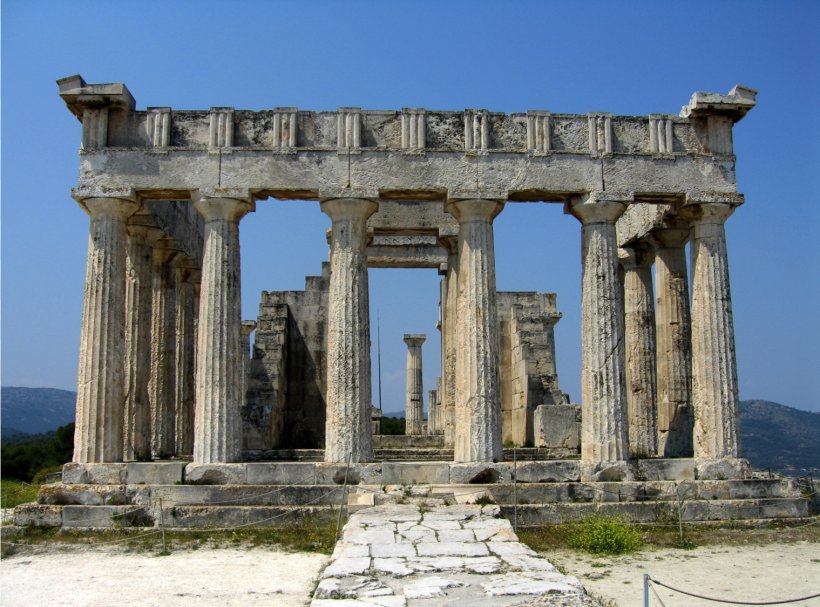The Temple of Aphaea is located within a sanctuary complex dedicated to the goddess Aphaia on the Greek island of Aigina, which lies in the Saronic Gulf.

Aphaia was a Greek goddess who was worshipped exclusively at this sanctuary. The extant temple of c. 500 BC was built over the remains of an earlier temple of c. 570 BC, which was destroyed by fire c. 510 BC. The elements of this destroyed temple were buried in the infill for the larger, flat terrace of the later temple, and are thus well preserved. Abundant traces of paint remain on many of these buried fragments. Significant quantities of Late Bronze Age figurines have been discovered at the site, including proportionally large numbers of female figurines indicating – perhaps – that cult activity at the site was continuous from the 14th century BC, suggesting a Minoan connection for the cult. The last temple is of an unusual plan and is also significant for its pedimental sculptures, which are thought to illustrate the change from Archaic to Early Classical technique. These sculptures are on display in the Glyptothek of Munich, with a number of fragments located in the museums at Aigina and on the site itself.
The sanctuary of Aphaia was located on the top of a hill c. 160 m in elevation at the northeast point of the island. The last form of the sanctuary covered an area of c. 80 by 80 m; earlier phases were less extensive and less well defined.
Bronze Age phase
In its earliest phase of use during the Bronze Age, the eastern area of the hilltop was an unwalled, open-air sanctuary to a female fertility and agricultural deity. Bronze Age figurines outnumber remains of pottery. Open vessel forms are also at an unusually high proportion versus closed vessels. There are no known settlements or burials in the vicinity, arguing against the remains being due to either usage.
Large numbers of small pottery chariots and thrones and miniature vessels have been found. Although there are scattered remains dating to the Early Bronze Age such as two seal stones, remains in significant quantities begin to be deposited in the Middle Bronze Age, and the sanctuary has its peak use in the LHIIIa2 through LHIIIb periods. It is less easy to trace the cult through the Sub-Mycenean period and into the Geometric where cult activity is once more reasonably certain.
Late Geometric phase
Furtwangler proposes three phases of building at the sanctuary, with the earliest of these demonstrated by an altar at the eastern end dating to c. 700 BC. Also securely known are a cistern at the northeast extremity and a structure identified as a treasury east of the propylon (entrance) of the sanctuary. The temple corresponding to these structures is proposed to be under the later temples and thus not able to be excavated.
Archaic phase (Aphaia Temple I)

Only detected a (stone socle and mudbrick upper level) peribolos wall enclosing an area of c. 40 by 45 m dating to this phase. This peribolos was not aligned to the axis of the temple. A raised and paved platform was built to connect the temple to the altar. There was a propylon (formal entrance gate) with a wooden superstructure in the southeast side of the peribolos. A 14 m tall column topped by a sphinx was at the northeast side of the sanctuary.
Late Archaic Phase (Aphaia Temple II)
Construction of a new temple commenced soon after the destruction of the older temple. The remains of the destroyed temple were removed from the site of the new temple and used to fill a c. 40 by 80 m terrace within the overall sanctuary of c. 80 by 80 m. This new temple terrace was aligned on north, west, and south with the plan of the new temple. The temple was a hexastyle peripteral Doric order structure on a 6 by 12 column plan resting on a 15.5 by 30.5 m platform; it had a distyle in antis cella with an opisthodomos and a pronaos.

Pedimental Sculptures
The marbles from the Late Archaic temple of Aphaia, comprising the sculptural groups of the east and west pediments of the temple, are on display in the Glyptothek of Munich, where they were restored by the Danish neoclassic sculptor Bertel Thorvaldsen.

Sculpture of a warrior from the east pediment of the Temple of Aphaia II.
These works exerted a formative influence on the local character of Neoclassicism in Munich, as exhibited in the architecture of Leo von Klenze. Each pediment centered on the figure of Athena, with groups of combatants, fallen warriors, and arms filling the decreasing angles of the pediments.

Sculpture of a warrior from the west pediment of the Temple of Aphaia II.
The theme shared by the pediments was the greatness of Aigina as shown by the exploits of its local heroes in the two Trojan wars, one led by Heracles against Laomedon and a second led by Agamemnon against Priam.